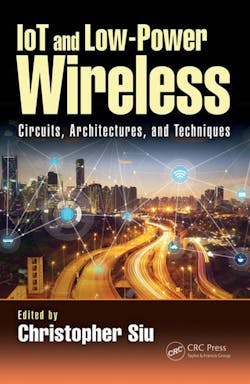Sometimes one good chapter is all that’s necessary to make a book worthwhile for a design engineer. The chapter Low-Power Wearable and Wireless Sensors for Advanced Healthcare and Monitoring might be one of those cases, although other chapters in the book entitled IoT and Low-Power Wireless Circuits, Architectures, and Techniques, edited by Christopher Siu, provide additional information.
Chapter 1, The Internet of Things | Physical and Link Layers Overview, presents an overview of IoT, focusing on the technologies deployed for the physical and link layers.
We’ll look at Chapter 2, Low-Power Wearable and Wireless Sensors for Advanced Healthcare and Monitoring, in more detail. It discusses low-power wearable and wireless sensors that have become a promising choice for advanced healthcare monitoring. Advances in sensing technology facilitate continuous health monitoring of patients, enables detection of disorders in the early stage, and can prevent potential life-threatening events.
One of the key points of low-power wearable devices is the successful integration of sensors, which has led to the development of different innovative tools equipped with a wide range of functionalities. Due to limited available power, it’s essential to design these sensors for a faster response, preferably without the need of traditional energy supply, while providing greater flexibility in terms of shape and layout.
Another important concept is minimum invasiveness and harmfulness, which are of primary interest in long-term medical monitoring. Different sensor technologies have matured for practical applications, and among them, polymeric sensors represent the fastest growing technologies for practical implementation of biomedical sensors. Consequently, readout circuits for charge-sensitive devices used for biosignal conditioning brought out new design challenges to meet the requirements in terms of sensitivity, noise, and power consumption.
Most wearable health-monitoring systems are battery-powered, and the operation of the system should require a minimum amount of power to prevent frequent replacement of the battery. Due to the interruption in health monitoring during battery replacement, battery-less energy harvesting has become an attractive solution for biomedical sensor applications.
Wireless devices for monitoring vital signs and other physiological parameters play a significant role in advancing modern home-based healthcare. Generally, biomedical signals have low frequency and thus require a low-data-rate transmitter for transmitting the data wirelessly. Unlike traditional radios for cellular application, these radios don’t transmit the data with high emission power as they are designed primarily for short-range communication. Most of these radios are either powered by the energy harvested from the ambient sources or tiny Li-polymer batteries.
For such an energy-constrained environment, the challenge lies in the design of a low-power radio that can sustain the short-range communication (~1-2 m) link for a long period of time without compromising its error rate There are low-power radio architectures and approaches for wearable low-data-rate biomedical sensing applications. Key challenges arise, though, in establishing a trustworthy communication link for these applications.
This chapter includes various wearable sensors that are currently being used in healthcare monitoring. Methodologies for low-power operation and wireless telemetry of these wearable biomedical sensors are also discussed. The chapter concludes with a brief discussion of possible future advances in this area.
For wearable healthcare monitoring sensors with wireless telemetry, energy and power consumption have become significant design criteria. To address the power constraint, circuit designers have implemented techniques either to reduce the overall power consumption of the system or find any suitable replacement for the conventional battery or alternative power source. In general, for an integrated-circuit system, total power consumption comprises two types of power consumption: static and dynamic.
Static power is typically associated with leakage current and dc current sources, while the dynamic power consumption is frequency-dependent and often dominates the total power. It’s associated with the charging and discharging of capacitive loads and the switching action of transistors connected between the power supplies. In the low-power design approach, current consumption is reduced by minimizing supply voltage, circuit complexity, clocking frequencies, dc current source values, and capacitance of the switching nodes.
There are several approaches to attain these ultra-low power design objectives, such as supply-voltage reduction, subthreshold design, body-driven differential logic, floating-gate transistors, self-cascode structure, and power management. Power consumption in an analog/RF circuit is proportional to the supply voltage and, therefore, can be reduced by lowering the supply voltage. This technique can also provide long-term device reliability by reducing the electric field.
However, continuous reduction of supply voltage is limited; the dynamic range in analog circuit and voltage headroom decreases with reduced power supply. The main challenge for the reduction of supply voltage with device scaling is that the threshold voltage and the drain-source saturation voltage don’t scale down at the same rate as the supply voltage.
Power Management
For a wearable sensor with wireless telemetry, a significant portion of the overall power is consumed during signal processing and wireless communication. Simultaneous power-management algorithms can play an important role to reduce the power consumption for wireless-sensor networks.
The key concept of the power-management technique is to reduce the transmission power by turning off the network nodes when not in use. If the network node is idle for a specific period of time, it’s automatically switched into sleep state, thus consuming a low amount of power. The system should have the capability of waking up from the idle node when it’s required to make measurements or transmit and receive data.
Efficient power management and reduction of power consumption can play an important role in the realization of wearable devices. However, the selection of power source is also an important factor to determine the overall lifespan of the sensor system, particularly for wearable and wireless applications. Usually, standard alkaline and Li-ion/NiMH/Li-polymer are the most common varieties of batteries to power up the sensor circuitries.
Due to the limited capacity of these batteries, energy harvesting has generated a significant interest among researchers. Energy harvesting can be used to recharge the batteries on a regular basis to maximize the system’s lifespan. On the other hand, it can replace the battery altogether to make the overall system self-powered and more convenient with reduced size and weight.
Still, the current state of energy harvesting isn’t capable of supplying the required level of power to fully power up the wearable and wireless sensors. Nevertheless, by merging the approaches to reduce the power consumption and increase the harnessed energy, it has the potential to address the tradeoff between performance parameters and lifetime of sensor nodes.
Energy can be harvested from many different sources. However, the selection of energy sources plays a vital role in the availability and controllability of the energy for use. For a controllable energy source, the energy can be harnessed as required by the application. On the other hand, a non-controllable source allows harvesting energy only when available.
Furthermore, the energy sources can also be classified as ambient energy sources, such as wind, solar, etc., and human power, such as the energy derived from human motion. Human power sources can be considered as attractive choices for energy harvesting for wearable sensor and healthcare monitoring, which are most likely to be attached to the human body.
Different activities of a human body can be utilized for harnessing the power, and their suitability depends on a particular sensor application. Some of these activities involve human motion like arm and leg movement, airflow in breathing etc. The resulting mechanical energy is transferred to electrical energy by utilizing the piezoelectric property of the transducers employed. Other sources, such as heat or friction, incorporate conversion technologies such as thermoelectricity or triboelectricity to generate electrical power.
Chapters 3 to 12
Following is a brief description of other chapters in the book.
- Chapter 3, Biomedical Algorithms for Wearable Monitoring: Algorithms can reliably interpret the physiological and biomechanical signals, derive metrics from them, and predict clinically significant events.
- Chapter 4, Approaches and Techniques for Maintenance and Operation of Multisink Wireless Sensor Networks: Distributed versus centralized architectures, and techniques that can improve the efficiency and robustness of the network.
- Chapter 5, Energy-Efficient Communication Solutions Based on Wake-Up Receivers: The wake-up receiver method to achieve energy-efficient communication.
- Chapter 6, All-Digital Noise-Shaping Time-to-Digital Converters for Mixed-Mode Signal Processing: An all-digital TDC (time-to-digital converter) architecture with delta-sigma noise shaping.
- Chapter 7, Power-Efficient CMOS Power Amplifiers for Wireless Applications: A systematic design technique, along with the analysis of a current-mode digital RF power amplifier incorporating predistortion.
- Chapter 8, Injection-Locking Techniques in Low-Power Wireless Systems: An analysis of various injection-locked techniques.
- Chapter 9, Low-Power RF Digital PLLs with Direct Carrier Modulation: The use of powerful digital calibration techniques in a direct modulation PLL has enabled further performance gains.
- Chapter 10, Frequency Synthesis Technique for 60 GHz Multi-Gbps Wireless: An injection-locked 60-GHz oscillator is used in conjunction with a subsampling PLL to achieve low power and low-phase noise.
- Chapter 11, 60 GHz Multiuser Gigabit/s Wireless Systems Based on IEEE 802.11ad/WiGig: The latest status of IEEE 802.11ad/WiGig in the 60-GHz band is presented, including a low-power CMOS transceiver with beamforming capability.
- Chapter 12, Adaptive and Efficient Integrated Power Management Structures for Inductive Power Delivery: An efficient power-management structure for inductive power delivery and its applications in markets such as implantable medical devices.
For more details, visit the Taylor & Francis website and the CRC Press website.
About the Author

Sam Davis
Sam Davis was the editor-in-chief of Power Electronics Technology magazine and website that is now part of Electronic Design. He has 18 years experience in electronic engineering design and management, six years in public relations and 25 years as a trade press editor. He holds a BSEE from Case-Western Reserve University, and did graduate work at the same school and UCLA. Sam was the editor for PCIM, the predecessor to Power Electronics Technology, from 1984 to 2004. His engineering experience includes circuit and system design for Litton Systems, Bunker-Ramo, Rocketdyne, and Clevite Corporation.. Design tasks included analog circuits, display systems, power supplies, underwater ordnance systems, and test systems. He also served as a program manager for a Litton Systems Navy program.
Sam is the author of Computer Data Displays, a book published by Prentice-Hall in the U.S. and Japan in 1969. He is also a recipient of the Jesse Neal Award for trade press editorial excellence, and has one patent for naval ship construction that simplifies electronic system integration.
You can also check out his Power Electronics blog.


